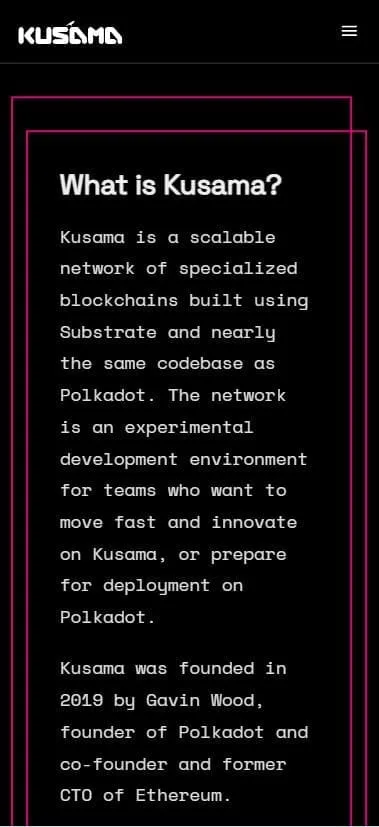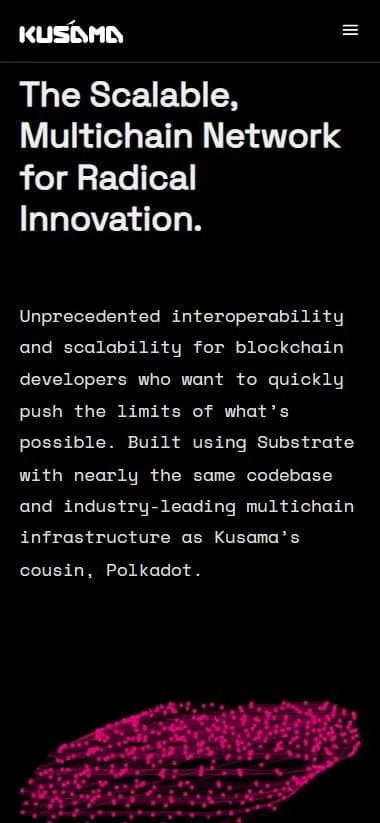What is Kusama? (KSM)

Kusama is a public, decentralized blockchain network designed as a canary network for Polkadot. It allows developers to experiment with and test new blockchain projects, applications, and upgrades before they are deployed on the more stable Polkadot network. Kusama’s purpose is to provide a pre-production environment where real-world testing can take place with live cryptocurrency and assets, giving projects a chance to gain traction and attract users before moving to Polkadot’s main network.
In short, Kusama acts as a sandbox for developers, offering a more flexible and experimental platform that operates under looser governance and faster decision-making processes than Polkadot. While it mimics many of Polkadot’s major features, Kusama is built to be faster and less stable, which is ideal for testing and experimentation.
Key Features of Kusama:
- Pre-production Environment: Kusama is a testing ground for new blockchain projects and Polkadot upgrades before they are deployed on Polkadot.
- Flexible Governance: Kusama has a more agile governance system than Polkadot, with quicker vote times and fewer restrictions for validators.
- Parachains and Relay Chain: Kusama uses a relay chain and parachains, allowing for a scalable and customizable ecosystem.
- Nominated Proof-of-Stake (NPoS): Kusama uses this consensus mechanism to secure its network, where both validators and nominators play a role in securing the network and validating transactions.
How Does Kusama Work?
Kusama uses two types of blockchains that work together to support the network’s scalability and functionality:
- Relay Chain:
- The main blockchain where transactions are finalized.
- It separates the process of adding transactions from the act of validating them, increasing network speed.
- It uses Nominated Proof-of-Stake (NPoS) for consensus, where validators and nominators work together to secure the network.
- Parachains:
- Parachains are custom blockchains built on Kusama, which leverage the security and computing power of the relay chain.
- These parachains can be customized to serve different functions and provide flexibility for developers.
- They interact with the relay chain to confirm the accuracy of transactions while retaining their unique features.
Nominated Proof-of-Stake (NPoS) Consensus:
- Validators: Validators on Kusama are responsible for validating parachain blocks, ensuring that transactions are accurate, and participating in the overall consensus process. Validators are chosen by nominators and must stake KSM tokens.
- Nominators: Nominators are individuals who stake their KSM tokens and select validators they trust. By nominating a validator, nominators allocate their votes to the validator they support. Nominators share in the rewards earned by validators they choose to back.
Users who stake KSM tokens in Kusama can participate in the governance system and receive rewards for supporting validators and maintaining the network.
Kusama Governance
Kusama operates a decentralized governance system, where token holders have significant influence over the network’s development and decision-making. There are three main governance bodies:
- The Referendum Chamber:
- Anyone holding KSM tokens can propose changes to the network or vote on major proposals.
- This system allows for active participation in decision-making, with voting on proposals taking place every seven days.
- The Council:
- The Council is an elected body of Kusama users who are responsible for proposing and deciding on changes to the network. The Council members are elected by KSM holders.
- The Council’s role is to ensure that the proposals from the referendum chamber align with the network’s overall goals and that governance is efficient.
- The Technical Committee:
- A group of teams actively developing on Kusama, the Technical Committee can make special proposals in case of emergencies or significant issues.
- This body can act quickly if needed and is voted in by the Council members.
Kusama vs. Polkadot
Kusama is often described as a “canary network” for Polkadot. This means it acts as an early testing ground for code that will later be deployed on Polkadot, but Kusama has several key differences from Polkadot:
- Governance Speed:
- Kusama has a faster governance system: it takes seven days to vote on a referendum and eight days for changes to be implemented, compared to one month for Polkadot.
- This quicker turnaround enables developers to test ideas and implement changes more rapidly.
- Validator Requirements:
- Kusama has lower staking and validator requirements compared to Polkadot. It is easier for users to become validators on Kusama, making it more accessible for developers and participants.
- Risk and Stability:
- Kusama sacrifices stability and security in favor of speed and flexibility. As a result, it is more prone to bugs or experimental features that may not be fully vetted, which is why it is used for testing and not for critical applications.
- Use Case:
- Polkadot is a stable platform for launching fully vetted, mission-critical projects, while Kusama is ideal for early-stage experimentation, development, and testing.
Why Use Kusama?
- Testing and Experimentation: Developers who want to launch new projects or test features related to Polkadot can do so in a more flexible, lower-risk environment.
- Low Barrier to Entry: With its lower requirements for validators and quicker voting times, Kusama provides a more accessible platform for both new developers and experienced blockchain teams.
- Early Feedback: Projects on Kusama can gather feedback from the community and make improvements before moving to Polkadot’s more secure and stable environment.
- KSM Staking and Rewards: Users who participate in Kusama by staking KSM tokens, nominating validators, and supporting the network can earn rewards.

























Reviews
There are no reviews yet.